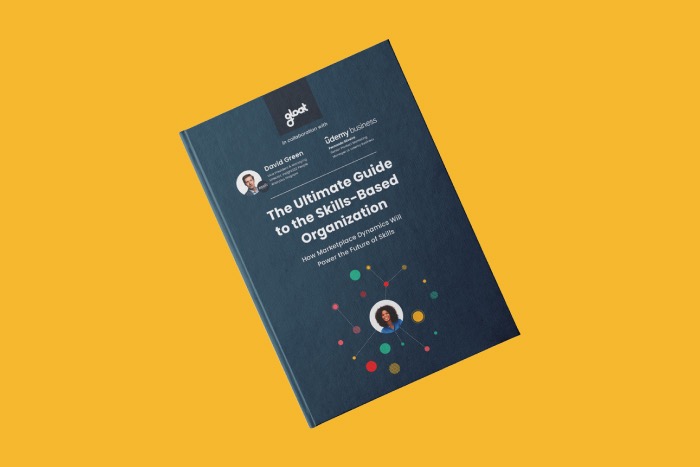Talent gap analysis: a complete guide
Learn how to bridge knowledge gaps before they impact business priorities

Learn how to bridge knowledge gaps before they impact business priorities
By now, most leaders and managers are familiar with talent gaps—because they’ve experienced them firsthand. They happen when employees don’t have the level of skills needed to complete a project or task to their employer’s expectations.
As the pace of digital innovation accelerates and the demand for highly skilled talent builds, gaps are becoming more common. 87% of companies are aware that they either already have a skills gap or that they will have one soon. In an effort to equip employees with the expertise they need, 64% of L&D professionals view reskilling the current workforce as a top priority.
Fortunately, talent gaps don’t need to be part of leaders’ daily realities. Businesses that can identify these skills shortages before they snowball into full-fledged gaps can proactively bridge them, ensuring they have the capabilities needed to thrive in the new world of work. That’s why talent gap analysis will be crucial for organizations that don’t want to fall victim to today’s ongoing skills shortage.
What are talent gaps?
A talent gap occurs when an organization’s current workforce doesn’t have the skills needed to meet the company’s goal. As technological innovations become more frequent and more profound, employees must learn new skills to keep pace. If they don’t, there’s a risk that talent gaps will start to widen, hindering your workforce’s ability to meet enterprise-wide goals.
Leaders can also think of talent gaps as the difference between the skills that are required for a particular job and the set of skills that an employee actually possesses. Talent gaps make it difficult for employees to complete tasks or projects efficiently and accurately.
Why do talent gaps occur?
Improvements in digital technologies are reinventing the way companies do business. Instead of evaluating organizational strategy annually, it must now be constantly recalibrated to account for rapidly changing priorities and innovations.
The acceleration of technological innovation and faster shifts in ways of working leave companies vulnerable to competency gaps, especially if there aren’t ample opportunities for upskilling and reskilling. Across all industries, businesses are grappling with shortages in crucial competencies; 64% of HR managers acknowledge that they don’t think their employees will be able to keep pace with future skills needs.
What is a talent gap analysis?
A talent gap analysis is a tool used to identify current and projected training and hiring requirements within an organization. It helps determine the gap between the present skills and competencies of a workforce or employee and the preferred skills and competencies.
A talent gap analysis helps HR leaders fill in the gaps in their organizational talent landscape, ensuring they’re developing a workforce that is competent, committed, and creative. Conducting a talent gap analysis can help leaders pinpoint what knowledge needs to be prioritized, such as additional technical training to overcome IT skills gaps.
Once HR is aware of any gaps in training and development, they can start creating strategies to bridge emerging skills shortages. Depending on the circumstances, HR leaders can decide whether it makes sense to hire externally for new skills (buy), or if it’s best to either upskill or reskill employees (build) or reallocate talent (borrow) to meet new priorities. This choice is also referred to as making a decision about when to build, buy, or borrow talent.
What is the process of a talent gap analysis?
As skill gaps widen and the hiring landscape grows more competitive, conducting a talent gap analysis is becoming a top priority for businesses that want to ensure their workforces have the capabilities they need. Here are a few steps to get started:
#1. Define organizational goals
Before your analysis begins, leaders across the organization should come together to align on enterprise-wide priorities and business objectives. After these goals are set, executives should also reflect on the skills that will be essential for turning these business aspirations into realities. Leaders should then define who will own various parts of each goal to ensure teams are empowered to work together to execute on these priorities.
#2. Take stock of skills
Once leaders have a clear idea of the goals they’re working towards and the skills their teams will need, executives must assess what capabilities their teams have today. Gaining a comprehensive picture of workforce skills has traditionally been challenging because much of this information has been siloed among disparate HR systems. Fortunately, a new generation of skills intelligence tools equips executives with complete visibility into the skills their people have, as well as spotlighting any potential knowledge gaps before they snowball into bigger problems.
#3. Develop a talent strategy
After executives understand the skills their people have, it’s time to create learning and development pathways to empower employees to hone the capabilities they’ll need to help their organization meet enterprise-wide goals. Visionary companies are introducing talent marketplaces to generate suggestions for projects, gigs, mentorships, and full-time roles that align with the skills an employee is looking to build and the work that business leaders deem a top priority.
#4. Implement solutions
In order to successfully complete your talent gap analysis, leaders must introduce the technology needed to identify where knowledge gaps lie and inform strategic workforce planning. Many companies are turning to skills intelligence tools like Gloat’s Skills Foundation to receive a unified view of skills across the enterprise, identify market trends on emerging skill gaps, and generate the creation of a skills-based architecture.
Why is a talent gap analysis beneficial?
A talent gap analysis is beneficial because it helps companies ensure their workforce is well-trained, knowledgeable, and equipped to perform the job assigned to them. Once knowledge gaps are identified through a talent gap analysis, HR teams can help employees cultivate the skills they’ll need to bridge them. Consequently, a talent gap analysis can help guide employees towards specific types of upskilling, reskilling, and cross-skilling that will be particularly beneficial for their organization and for their role.
It can also streamline the recruitment process by giving talent acquisition teams clarity about which skills and competencies they should prioritize when evaluating external candidates. Talent gap analysis is one of the most accurate and effective ways to identify knowledge that’s missing within the organization. Once leaders have this information, they can harness tools like Skills Foundation to make informed workforce planning decisions.
4 steps leaders can take to identify and bridge talent gaps
While skill needs and business priorities will continue to shift, there are a few steps leaders can take to ensure they’re proactively bridging talent gaps.
#1. Create your single source of truth for skills
Before HR leaders can begin bridging talent gaps, they need full visibility into all of the skills within their organization. Most taxonomies are out of date, leading to talent strategies that may not address the actual needs of the organization.
Rather than settling for this subpar understanding of skills, companies are harnessing skills intelligence tools to gain full visibility into all of their people’s capabilities. These systems are updated in real-time and pull from an employee’s LinkedIn profile or CV so managers don’t have to worry about overlooking in-demand talent.
#2. Identify current and potential knowledge gaps
Once leaders have a clear picture of the skills within their workforce, they can begin to identify where their organizational knowledge may be falling short of industry standards. Instead of guessing which skills will become more important in the new world of work, skills intelligence tools equip leaders with the insights they’re looking for.
#3. Empower employees to expand their skills
Beyond acquiring skills through external hiring, employees should be encouraged to develop their knowledge so they can move into new roles within their organization. To prevent gaps in training and development from holding employees back, HR leaders should ensure their workforce has access to experiential learning opportunities that will enable them to build on-the-job expertise. By generating suggestions for projects, gigs, and mentorships based on the skills employees wish to learn, talent marketplaces increase access to career development opportunities.
#4. Learn when to build, buy, and borrow talent
As budgets tighten and knowledge gaps widen, HR leaders will need to make strategic workforce planning decisions about when to build, borrow, and buy talent. To guide this decision-making process, companies are harnessing skills intelligence tools. These systems can give leaders a pulse on what roles are becoming outdated and which should be prioritized for emerging needs so that executives can effectively plan for the future.
To learn more about what it takes to ensure your company has the skills needed to thrive in the new world of work, check out our ultimate guide to the skills-based organization.





